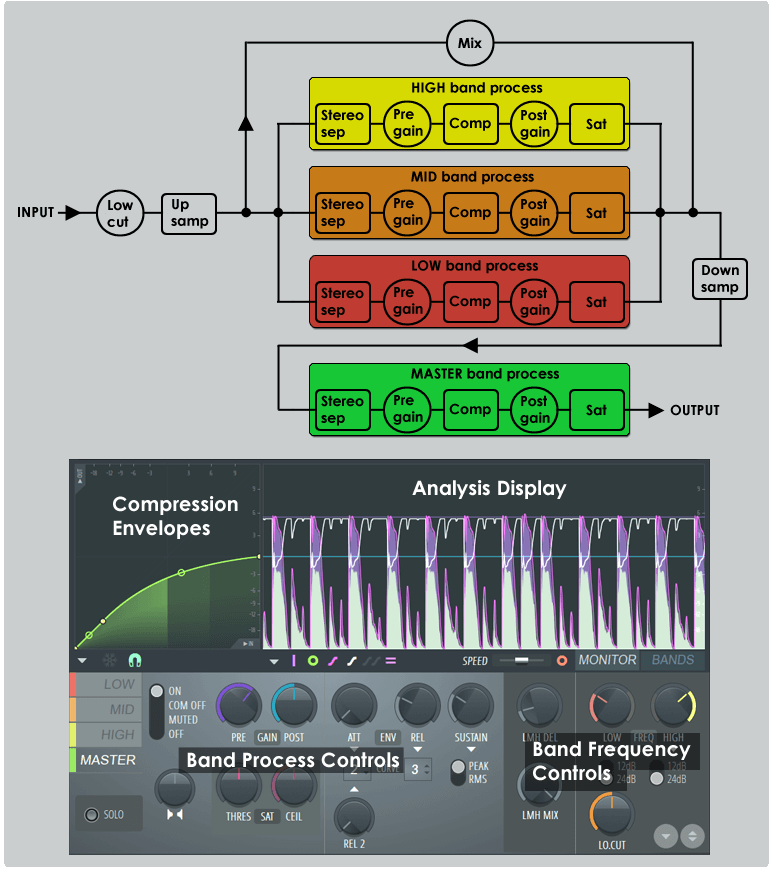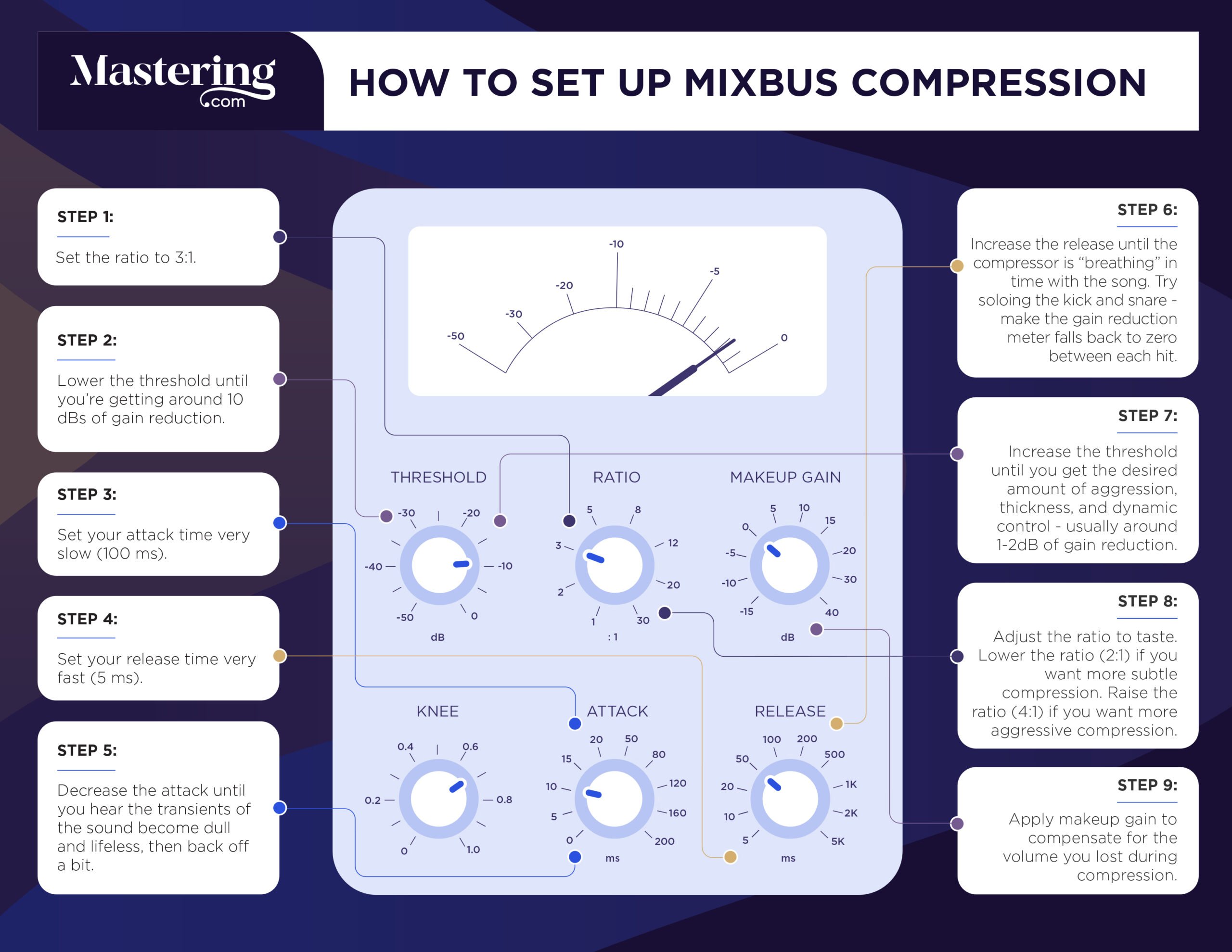Learn how to effectively use parallel compression to enhance your audio tracks for a fuller sound. Discover the step-by-step process and tips for implementing this advanced compression technique in your music production.
Parallel compression, also known as New York compression, is a powerful tool that can help you achieve a dynamic and punchy sound in your mixes. By blending a heavily compressed signal with the original track, you can add depth and presence to your music while maintaining the natural dynamics of the original recording.
Follow our guide to understand the ins and outs of parallel compression and take your music production skills to the next level.
Understanding Parallel Compression
What Is Parallel Compression?
Parallel compression blends the compressed and uncompressed signals to create a more dynamic sound.
Benefits Of Using Parallel Compression
- Preserves Dynamics: Retains the natural peaks and nuances of the original signal.
- Enhanced Tone: Adds depth and fullness to the audio without sacrificing clarity.
- Control Over Dynamics: Allows fine-tuning of the compression level to suit different elements in the mix.
- Increased Impact: Amplifies the presence and power of instruments or vocals.
Setting Up Parallel Compression
Parallel compression can greatly enhance the impact and dynamic range of your audio tracks. To make the most of this technique, it’s essential to set it up correctly. Here we will guide you through the process of getting your parallel compression up and running smoothly.
- Choose a sound source with a wide dynamic range.
- Opt for bus or group tracks for parallel processing.
- Ensure a clean audio signal free from noise or clipping.
- Set the compression ratio between 3:1 and 6:1 for parallel compression.
- Adjust the attack and release times to suit the source material.
- Keep the threshold low to capture more transient details.
Mastering Dynamic Control
Mastering dynamic control is a crucial aspect of achieving balanced and powerful audio mixes. Utilizing parallel compression is a game-changing technique that empowers you to fine-tune dynamic range and impact to perfection. By understanding the nuances of parallel compression, you can take your audio production skills to the next level and achieve professional-grade results.
Fine-tuning With Parallel Compression
Parallel compression, also known as New York compression, allows for the fine-tuning of individual track dynamics while preserving the natural transients and nuances of the original signal. By blending the heavily compressed signal with the dry, uncompressed signal, you can achieve a perfect balance of punch and clarity in your audio mixes. This technique enables you to retain the natural dynamics of the audio while adding impactful and controlled compression, resulting in a more polished and professional sound.
Balancing Dynamic Range And Impact
Mastering dynamic control through parallel compression involves finding the optimal balance between the dynamic range and impact of a track. Balancing the intensity of the compressed signal with the original dry signal is key to achieving a powerful and cohesive mix. Through careful adjustment of compression settings and blending ratios, you can ensure that your audio maintains its dynamics while delivering a captivating and impactful sonic experience.

Credit: www.image-line.com
Advanced Techniques
Learn advanced parallel compression techniques to enhance your audio mixing skills. Implementing parallel compression can add depth and energy to your sound, producing professional-grade results. Mastering these methods will elevate your audio productions to the next level.
Parallel Compression With Multiband Processing
One of the advanced techniques you can explore when using parallel compression is incorporating multiband processing. This approach allows you to have even more control over your mix, enhancing the overall audio dynamics and clarity.
With multiband processing, you can split your audio signal into different frequency bands, applying compression to each band separately. This enables you to target specific frequencies and address any imbalances in your mix, resulting in a more polished and professional sound.
By using parallel compression with multiband processing, you can retain the dynamics of your mix while simultaneously shaping the tonal balance. This technique is particularly effective in situations where certain frequency ranges need shaping and control without affecting the overall balance of the mix.
To implement parallel compression with multiband processing, you will need a plugin or a hardware unit that supports this functionality. Set up separate parallel chains for each frequency band and adjust the compression settings based on the characteristics of each band. Experiment with different threshold, ratio, attack, and release settings to achieve the desired tonal balance.
Creative Parallel Compression Applications
Besides its utility in balancing audio dynamics and tonal shaping, parallel compression can also be creatively utilized in various audio production scenarios. Here are a few innovative ways you can apply this technique:
- Enhancing drum sounds: Use parallel compression on your drum bus to add sustain and impact, making the drums cut through the mix.
- Emphasizing vocals: Apply parallel compression to your vocal track to make it sound fuller, more present, and stand out in the mix.
- Giving life to guitars: Parallel compression can help make guitars sound more vigorous and prominent in the mix without sacrificing the natural tonal characteristics.
- Enlivening synth sounds: Use parallel compression on your synthesizer tracks to add depth, brightness, and sustain to create more captivating and dynamic synth textures.
- Adding impact to bass: Apply parallel compression to your bass tracks to enhance the attack and sustain, making them tighter and more punchy.
These are just a few examples of how you can explore the creative potential of parallel compression in your audio productions. Don’t be afraid to experiment and push the boundaries to achieve interesting and unique results.
Tips And Best Practices
When it comes to parallel compression, there are a few tips and best practices that can help you achieve optimal results. In this section, we will discuss two key aspects to consider: avoiding over-compression and experimenting with parallel compression chains.
Avoiding Over-compression
Over-compression can result in a loss of dynamics and an unnatural sound. To avoid this, follow these guidelines:
- Set the right threshold: Start by setting the compression threshold to a level where it only activates during the loudest parts of the audio.
- Use a conservative ratio: Keep the compression ratio moderate to maintain the natural dynamics of the audio. A ratio between 2:1 and 4:1 is typically a good starting point.
- Gradually adjust attack and release times: Start with medium attack and release times, and then make small adjustments to find the perfect balance between controlling the audio and preserving its dynamics.
- Avoid excessive gain reduction: Limit the amount of gain reduction to avoid squashing the audio. Aim for a reduction of around 3 to 6 dB.
Experimenting With Parallel Compression Chains
Parallel compression chains offer a flexible way of enhancing the audio by mixing the uncompressed and compressed signals together. Here are some tips to make the most out of this technique:
- Create multiple parallel chains: Instead of using a single parallel chain, try creating multiple chains with different settings and blending them together. This allows for more control and can result in a more nuanced and unique sound.
- Consider the order of effects: Experiment with the order of effects within the parallel chains. For example, placing EQ before compression can help shape the sound before it hits the compressor.
- Blend to taste: Adjust the blend between the compressed and uncompressed signals until you achieve the desired sound. This allows you to retain the dynamics of the original audio while adding the benefits of compression.
- Use automation: Explore automating the parameters of the parallel compressors to create dynamic changes throughout the track. This can add excitement and variation to the audio.

Credit: mastering.com

Credit: www.soundonsound.com
Frequently Asked Questions On Parallel Compression Guide
What Should I Use Parallel Compression On?
Use parallel compression on individual tracks or the master bus to enhance dynamics and add depth to your mix.
What Is The Threshold For Parallel Compression?
The threshold for parallel compression is set at a level where the compressed signal blends seamlessly with the dry signal. It helps maintain dynamics while adding depth and punch to the audio. Adjust the threshold based on the desired balance between compression and original signal.
Should Parallel Compression Be Pre Or Post Fader?
Use parallel compression post-fader to blend the compressed signal with the original. This allows for greater control over the mix and helps maintain a more natural sound.
What Is The Ratio For Parallel Compression Drums?
The ratio for parallel compression drums is typically 3:1 or 4:1. This helps blend the uncompressed original drum sound with a compressed version, resulting in more dynamic and controlled drums. It adds punch and thickness while retaining the natural dynamics of the drums.
Conclusion
When used correctly, parallel compression can enhance the depth and power of your mixes. By blending the compressed and uncompressed signals, you preserve dynamics while adding weight and presence. Experiment with different settings and techniques to find what works best for your sound.
Embrace parallel compression as a valuable tool in your audio production arsenal.